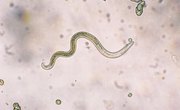
Nematodes are all around us, whether you realize it or not. The worm-like organisms have found ways to thrive in every ecosystem on Earth, from the dark bottoms of ocean floors to barren deserts to icy mountaintops. The thousands of different types of nematodes take on different roles on our planet. Sometimes, that works out well for humans, like when soil-dwelling nematodes enrich the ground around them or keep it pest free. Other times, though, parasitic nematodes can stealthily spread disease, leading to massive outbreaks of potentially fatal illnesses in crops, animals and humans.
Scientists still have a lot to learn about the many different types of nematodes. But a basic understanding of what we do know can help you learn how to avoid potentially dangerous nematodes in places like your garden and give you a greater appreciation for all the nematode life teeming around you.
What is a Nematode?
A 2013 animal biodiversity study estimated that there are 25,043 species of nematodes, making it one of the most plentiful species on the planet. With so many different and diverse types of species under one umbrella, it can be difficult to nail down exactly what a nematode is. They all do share some characteristics, however.
For one, nematodes are often referred to as roundworms, since most have cylindrical bodies with tapered ends that make them appear as worms. They're bilaterally symmetrical, and most have digestive and excretory systems that break down food and turn it into enzymes. Many are microscopic, and most are only a few inches long at most. But they’re not all tiny. One parasitic nematode, Placentonema gigantissima, grew to more than 20 feet long in the placenta of its host, a sperm whale.
Nematodes have found ways to thrive in an incredibly diverse group of habitats across the planet. They're most commonly found burrowing in soil, both above land and far below the ocean’s surface. Marine nematodes are one of the most plentiful multicellular organisms that live on the ocean’s floor, an area too cold, dark and pressurized for most animals to withstand. There, they play a critical decomposing role in the ocean’s ecosystem.
Scientists have also discovered them in extreme environments above ground. The tiny Halicephalobus mephisto, for example, lives in the depths of a South African gold mine where temperatures regularly hit more than 100 degrees.
Classes of Nematodes
Biologists are constantly discovering new types of nematodes and working to better understand their unique characteristics. Because of that, there isn't complete agreement on how exactly to classify this incredibly diverse and numerous bunch of organisms.
The roundworm phylum is nematoda. After that, phylum nematoda classes are broken down into more specific classifications. In the past, there were two classes of nematodes called Secernentea and Adenophorea, also known as Aphasmidia. An Aphasmidia example includes Trichinellidae, the roundworm that lives in undercooked meat and causes the disease Trichinosis.
Now, though, as scientists are able to better study the DNA of the many different types of nematodes, some biologists believe they have a more complete and complex classification system for the creatures based on the small subunit ribosomal DNA, or SSU rDNA, of nematodes. Those two classes are Enoplea and Chromadorea.
Enoplea: Generally thought to have been around longer than the Chromadorea. They typically have a cylindrical esophagus, as well as amphids (the sensory organs that allow them to respond to stimuli) that are shaped similarly to pockets.
Chromadorea: Believed to have evolved from the Eenoplea with slightly more complex excretory systems than their Enoplea counterparts. Their esophagi are typically more round than the cylindrical ones of Enoplea, and their amphids are more commonly shaped like slits or spirals.
Dangerous Nematoda Examples in Agriculture
Nematodes are almost unfathomably abundant in soil. A single handful of soil could contain thousands of different types of nematodes, some too small to be seen with the naked eye and others big enough to see and feel wriggling around your fingertips. Another handful of soil in a totally different landscape could yield an entirely different thousand types of roundworms.
While some of those nematodes go about their business without harming anyone, others are responsible for the spread of plant diseases that can cripple entire crops and cause agricultural devastation. Microscopic parasitic root knot nematodes spread easily – they can be blown in the wind or attach to a bird that flies over a vulnerable crop. Then, they usually attack the root of a plant, causing it to slowly wilt and die.
Root crops like potatoes and radishes, as well as some fruits that grow in orchards, such as peaches, are highly vulnerable. In order to keep their plants healthy, farmers must follow government regulations about nematode-free fertilizer and soil and use methods like crop rotation, cover crops and pesticides to prevent the spread of root knot nematodes.
Beneficial Nematodes for Gardens
Of course, not all roundworms are out to destroy. Some, known as entomopathogenic nematodes, or beneficial nematodes, are great additions to gardens and farms around the world. Some work hard to enrich the soil around them. Others release a beneficial bacteria that's able to kill harmful pests without harming any of the plant or animal life around it. Many farmers and gardeners looking to steer clear of chemical-laden pesticides buy beneficial roundworms to add to their crops as an organic pesticide option. If you’re a home gardener, you might be interested in adding some of these beneficial nematodes to your greenery:
Heterorhabditis bacteriophora: Commonly used in orchards and open pastures where it's great at keeping away pests like flea beetles, queen ants, ticks and weevils.
Steinernema carpocapsae: Can survive in a diverse group of climates including ocean beaches, deserts and forests. Helpful for keeping away pests including caterpillars, flea larvae, pine weevils, soldier ants and fly larvae.
Roundworms Dangerous to Animals and Humans
Unfortunately, there are many types of nematodes that can cause serious disease or even death in humans and animals. Roundworm disease is passed via human feces, mosquitos that are transmitting nematode bacteria, unwashed and raw or undercooked food or exposure to contaminated soil.
One of the most common to affect animals is heartworm, which can cause coughing, extreme fatigue, breathing troubles and, if left untreated, death. If you have a pet dog or cat, your vet has likely recommended giving them preventive medicine.
Other roundworms can cause diseases you've likely heard of, including trichinosis, ascariasis, hookworm, pinworm and whipworm. Most of these parasitic nematodes attack the gut and can cause severe abdominal pain, bleeding, anemia, diarrhea and muscle weakness. Sometimes, as is the case with the Ascaris lumbricoides roundworm that causes Ascariasis, the roundworm feeds directly off the digest contents of a person’s intestine. Some people don’t have any symptoms, but as the roundworm grows and feeds off the food they need to survive, the host may begin to feel symptoms of malnutrition.
Most roundworm diseases are treatable with the right medical care but can cause widespread problems and even death in underdeveloped areas of the world where sanitation and medical resources are lacking.
Hopefully, an understanding of the vast array of nematodes and the roles they play in Earth’s ecosystem can help you avoid the parasitic ones and reap the benefits of the helpful ones in the future.
References
About the Author
Rachelle Dragani is a freelance writer based in Brooklyn with extensive experience covering the latest innovation and development in the world of science. Her pieces on topics including DNA sequencing, tissue engineering and stem cell advances have been featured in publications including BioTechniques: the International Journal of Life Science Methods, Popular Mechanics, Futurism and Gizmodo.
